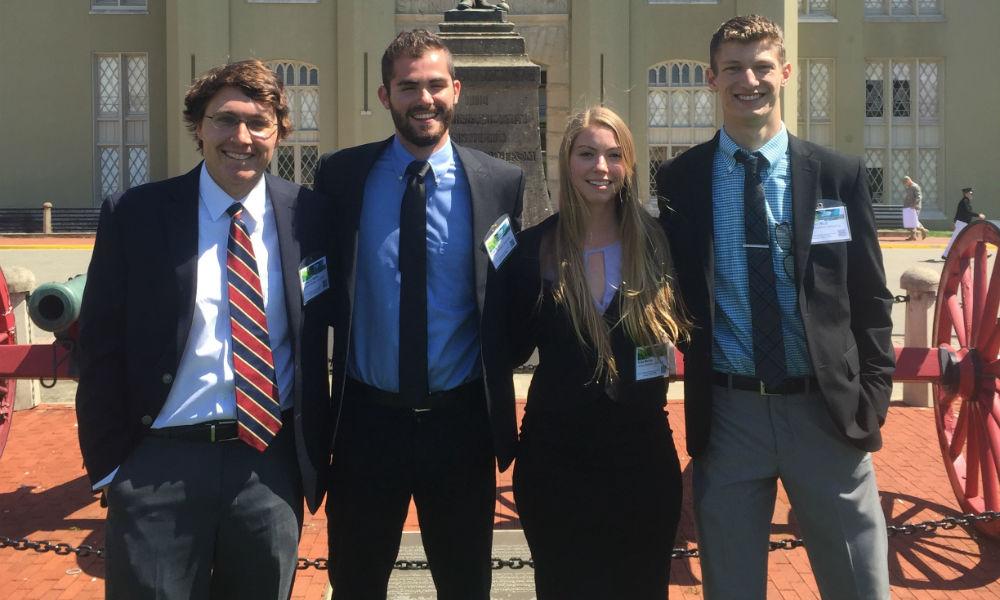JMU ISAT Department on the Frontlines for Solar Energy
A senior capstone project opens doors for ISAT students
News
SUMMARY: Student research could lead to the greater use of solar energy throughout the state of Virginia.
By: Brett Seekford, Creative Services
In an effort to ensure a sustainable future, researchers have studied solar energy as an alternative to fossil fuels. Virginia, however, ranks near the bottom of the list of states producing solar power while North Carolina and Maryland have made it a priority. Failing to attract progressive businesses like Google due to this shortcoming, Governor Terry McAuliffe recently outlined a vision for solar energy at the Virginia Military Institute (VMI) as a part of the Environment Virginia Symposium. A group of JMU students presenting at the conference, however, already studied patterns of solar energy use and methods to promote it.
These students – Cameron Stalker (’16), Greg Von Wald (’16), Erika Murray (’16), and Cory Byrne (’17) – did not originally plan on researching solar energy. They started by working for almost a year on improving energy efficiency in boilers through Wholesome Energy for their senior ISAT capstone project. After the business owners suffered several tragedies, including their facility being burned to the ground, the group was put in a waiting period.
A year passed, and they considered pursuing another project so they could graduate on time. Stalker suggested his group contact Sigora Solar, a Waynesboro installation company he interned for over the summer. They ultimately made the difficult decision to start from scratch.
Whereas capstone projects normally span two years, this group only had a year to complete their project. They jumped head-first into their work, contacting John Merrier (’10), a JMU alum who works at a local energy company called Antares. Through their correspondence, these students and their project advisor, Dr. Chris Bachmann, realized data regarding locations of solar panel installations was not available through the state. They found a need to be met and began compiling information to locate homes across Virginia using solar panels.
By reaching out to county offices and the Department of Minerals, Mines and Energy, they were able to acquire building permit records that pinpointed the houses with solar panel installations. Using mapping technology, they plotted the locations across the state. They proceeded to the next step of their project: Finding out why the people requested the solar panels
“We decided to send out easy surveys to residents who requested the installments to gauge their satisfaction,” Bachmann explained. “Sending all of those mailers is expensive, costing roughly $1,000. That’s where our donors played such a crucial role.”
In 2015, Avi and Lauren Elmakis, two JMU alums, made a generous donation in honor of Dr. Cindy Klevickis, their favorite faculty member while undergraduate students. The founding of the Dr. Cynthia A. Klevickis Faculty Support Endowment led to the distribution of $1,000 to support Bachmann’s work with students completing their capstone projects. He decided to use it to send these surveys across the state. While the team only expected roughly one-hundred responses, they were surprised to receive more than 650 completed surveys. These results were also revealing. The students found many of these homeowners sought solar panel installations because of their commitment to environmental stewardship, suggesting they had the financial means to afford the panels. Their findings also indicate most homeowners are pleased with their panels’ energy production.
This outreach led to an ongoing dialogue with solar panel users. “We were inundated with emails and phone calls from enthusiastic recipients, indicating that there is a strong desire for residential adopters to share their story, yet no medium for their voice to be heard,” Bachmann said.
After submitting an abstract to present at the Environment Virginia Symposium, conference organizers invited the group to present their research at VMI. Their presentation followed the governor’s speech and attracted much interest. Representatives from Appalachian Power and Luck Enterprises approached them afterward, inviting the group to present their study in Richmond this past May.
The students collectively agreed their research could lead to the greater use of solar energy throughout the state. “I’ve realized Virginia can rely more on solar energy to meet our needs. This makes me wonder why we’re not using it,” Von Wald said. “JMU gave us the tools to investigate these questions and identify ways to promote a future powered by solar.”
The project isn’t over either. The interest spurred by these findings has led the students and Bachmann to consider constructing a website allowing solar panel users to review their experiences online so other potential buyers can see the positive or negative effects of an installation. Cory Byrne, a class year behind his other group members, plans to continue working on the project as he completes his capstone.
This project has also opened doors for the graduating seniors in the group. Stalker has accepted a permanent position with Sigora Solar after graduation. Von Wald and Murray are both pursuing graduate education, and Von Wald has committed to Stanford University while Murray looks forward to attending Northeastern University in the fall. Their work, while positively affecting the growth of solar energy in the state, has also helped them achieve their personal goals.
The ISAT capstone requirement is an opportunity for students to make a difference in their communities while preparing them for careers or higher education. This alliance of JMU students, faculty, alumni, and donors reflects the university’s mission to secure a sustainable future through engagement with the larger community.
